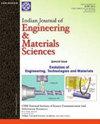Polyvinyl Alcohol Composite Films Reinforced with Taro (Colocasia esculenta) Stem Fiber: Thermal, Mechanical and Biodegradation Studies
IF 0.6
4区 工程技术
Q3 ENGINEERING, MULTIDISCIPLINARY
Indian Journal of Engineering and Materials Sciences
Pub Date : 2023-01-01
DOI:10.56042/ijems.v30i2.1499
引用次数: 0
Abstract
Polyvinyl alcohol/Glycerol/Citric acid based composite samples have been synthesized by the method of solvent casting. The composites have been explored in terms of thermal, tensile, biodegradability, water absorption analysis and SEM study with the addition of Colocasia esculenta stem fiber (2.5-20.0 %). The equilibrium water absorption percentage with the addition of fiber and upon the increasing content of fiber has been found to be increased with an abrupt change above 12.5 % fiber content. The high value of degradation percentage has been however observed with 20 % loading of fiber (29.13±1.28). Thermal stability of the composite films has also been found to show positive results with the addition of fiber with maximum value of onset degradation temperature obtained with 7.5 % reinforcement. The incorporation of fiber has resulted in enhancement of tensile strength due to modified interfacial adhesion between fiber and matrix with maximum value of 36.06±0.25 MPa obtained for composite with 7.5 % loading of fiber. SEM micrographs have shown the smooth and homogeneous surface of composite film without any loading of fiber (CE-0). High loading of fiber (20 %) however has introduced some voids, holes and cracks in the samples making it easy for water molecules to permeate in the composites responsible for its water absorption percentage.芋(Colocasia esculenta)茎纤维增强聚乙烯醇复合膜:热、力学和生物降解研究
采用溶剂铸造法合成了聚乙烯醇/甘油/柠檬酸基复合样品。对添加2.5% ~ 20.0%绿芋茎纤维的复合材料进行了热性能、拉伸性能、生物降解性、吸水性分析和扫描电镜研究。平衡吸水率随纤维添加量的增加和纤维含量的增加而增加,纤维含量在12.5%以上发生突变。当纤维负荷为20%时,降解率最高(29.13±1.28)。纤维的加入对复合膜的热稳定性也有积极的影响,当纤维的增强率为7.5%时,复合膜的起始降解温度达到最大值。纤维的加入提高了复合材料的抗拉强度,纤维与基体之间的界面附着力得到了改善,当纤维含量为7.5%时,复合材料的抗拉强度最大值为36.06±0.25 MPa。SEM显微图显示复合膜表面光滑均匀,没有任何纤维(CE-0)的加载。然而,纤维的高负荷(20%)在样品中引入了一些空隙、孔洞和裂缝,使水分子很容易渗透到复合材料中,从而影响其吸水率。
本文章由计算机程序翻译,如有差异,请以英文原文为准。
求助全文
约1分钟内获得全文
求助全文
来源期刊

Indian Journal of Engineering and Materials Sciences
工程技术-材料科学:综合
CiteScore
1.70
自引率
11.10%
发文量
57
审稿时长
9 months
期刊介绍:
Started in 1994, it publishes papers in aerospace engineering, mechanical engineering, metallurgical engineering, electrical/electronics engineering, computer science and engineering; civil engineering, environmental engineering, heat transfer, fluid mechanics, instrumentation, and materials science.
 求助内容:
求助内容: 应助结果提醒方式:
应助结果提醒方式:


